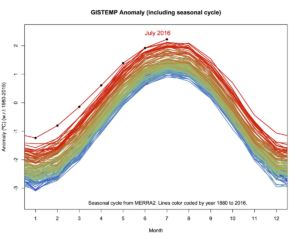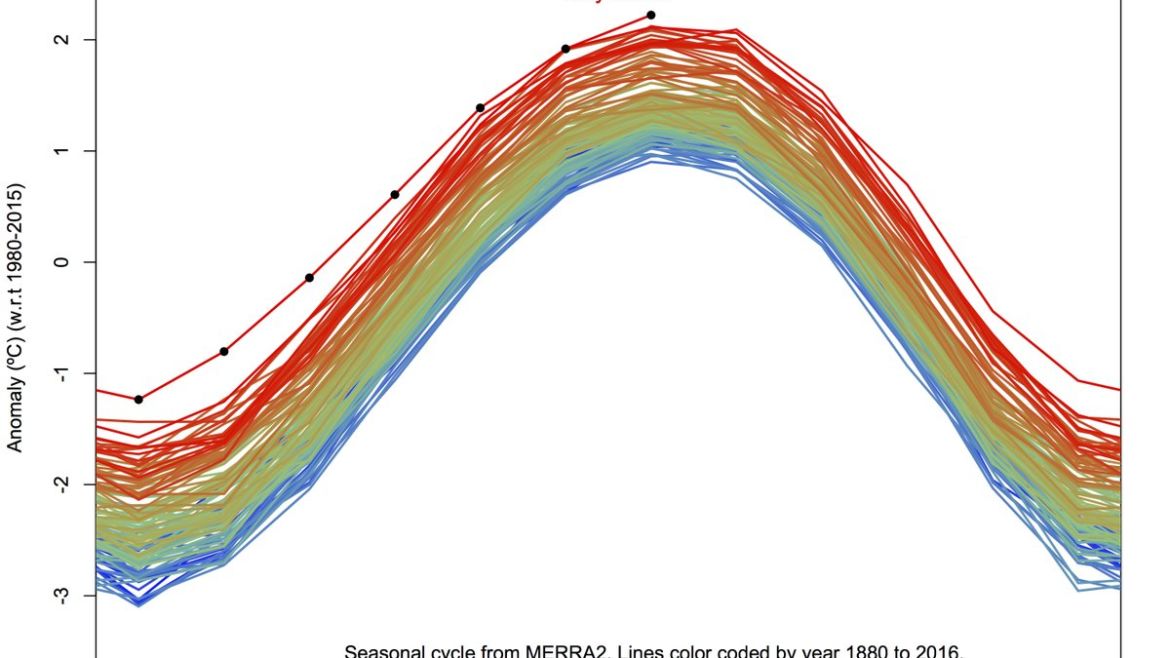136. That’s how many years that the global temperature has been measured. And this is going to be the hottest one since 1880.
This post continues to follow the theme of what a changing, warming climate means to YOU and other humans around the globe. My recent article about Rain Bombs seems to be playing out in Louisiana unfortunately. It is heartbreaking to see what is happening there, again. These horrendous weather events which are becoming more and more severe and happening much more frequently, are causing real human suffering and death and billions of dollars of damage. Of course, it’s not just too much rain at one time in a concentrated area. But also, drought combined with decades of fire suppression that are causing life and property loss in increasing amounts from more frequent and larger fires in places like California right now.
And yet, as the second article below points out, there is some good news about our ability to change, adopt and transition to a new normal. Despite record heat and heat waves, our power grid is working well…better than ever despite the shutdown of hundreds of coal fired power plants. Grid improvements, conservation plus the addition of wind farms and rooftop solar are helping to make this possible without causing harm to the economy.
(I’ve strayed from my usual highlighting in green for the first article to use red only to represent how hot it is really getting.)
 July was the hottest month ever — NASA
July was the hottest month ever — NASA
Tuesday, August 16, 2016
July was the hottest month in recorded history, NASA said yesterday.
The report comes as the past nine months have set hottest-temperature records for their respective months. July extends that streak to 10 months.
The El Niño weather phenomenon likely contributed to last month’s high mark. NASA measures air and sea temperatures for its determinations.
University of Melbourne climate scientist David Karoly said it is “virtually certain” that 2016 will be the hottest recorded year ever.
The first temperature data were recorded in 1880 (Michael Slezak, London Guardian, Aug. 15). — CB
Power Grid Hums Along During Heat Wave Thanks to Upgrades
Rod Kuckro and Edward Klump, E&E reporters
Thursday, August 18, 2016
Despite record-setting temperatures and unprecedented demand for electricity across much of the United States in recent weeks, the nation’s power grid has been able to deliver electricity when called on without any major problems.
The nation’s grid overseer, the North American Electric Reliability Corp., has a Bulk Power System Awareness team that monitors reliability issues in near-real time. “To date, we have seen no heat-related reliability impacts to the bulk power system,” said NERC spokeswoman Kimberly Mielcarek.
That degree of reliability is largely due to improvements in transmission planning and additions and upgrades to the bulk power system, which is characterized by high-voltage lines above 135 kilovolts.
According to the Energy Information Administration, between 1997 and 2012 electric transmission investments by private companies and investors increased fivefold in real terms (2012 dollars), growing from $2.7 billion in 1997 to $14.1 billion in 2012 — reversing a three-decade decline.
That investment has picked up even more in the past few years as transmission owners look to retool their systems to cope with the closure of baseload coal plants, the addition of far-flung wind resources and changes needed to help comply with federal environmental mandates.
And the persistence of energy efficiency efforts, coupled with behind-the-meter investments in systems such as rooftop solar that cannot be monitored easily by a grid operator, has led to flat demand growth, which in turn led to healthy levels of excess generation capacity, or reserve margins, in most parts of the country.
New Jersey’s Public Service Electric and Gas Co. yesterday touted a newly in-service transmission line — the $125 million Sewaren-Metuchen 230-kV project — as evidence that reliability can be attributed to investments in transmission.
“This recent heat wave put our utility systems to the test,” John Latka, senior vice president of electric and gas operations, said in a blog post.
There were no brownouts or voltage reductions, measures a utility typically takes when demand for electricity exceeds supply, he said. “Ten years ago, brownouts during heat waves were common,” he said.
“Over the past few years, we’ve made significant investments in our transmission system that enable us to transport more electricity, more reliably than ever before. These upgrades also mean we can import more power into ‘load pockets’ — areas that require more energy during extreme heat,” he said.
Still, “even with all of this additional capacity and upgrades, equipment does sometimes fail,” Latka said, but those isolated incidents were due to equipment becoming overheated, overloaded or both.
Likewise, New York’s Consolidated Edison Inc. saw sporadic outages in recent weeks and repeatedly issued calls for customers to conserve energy as it reduced voltage by 5 percent as a precaution to protect equipment and maintain service as repairs are made.
But in the nation’s largest grid, PJM Interconnection LLC, which serves more than 61 million people in 13 states and the District of Columbia, there have been “no grid problems during the heat,” said spokesman Ray Dotter.
The highest demand so far this summer was 152,890 megawatts on Aug. 11, the 11th highest all-time peak demand for PJM, Dotter said.
Forecast peaks this week are in the lower 140,000 MW.
Dotter credited “transmission additions/upgrades in recent years that have improved ability to move power and lessened some constraints,” as well as retiring coal generation in the western part of PJM’s system and replacing that generation with natural-gas-fired generation further east and closer to load centers where electricity demand is greater.
In ISO New England Inc., “system conditions are normal currently, and the regional power system operated reliably throughout the heat wave,” said spokeswoman Marcia Blomberg.
As a precautionary measure, the ISO has issued alerts as recently as last Thursday directing markets to cease any routine maintenance, construction or test activities on their equipment that could jeopardize the reliability of the power system.
Last Thursday, “heat and humidity drove up demand for power, while several generators were unable to operate or had to lower their output due to various mechanical problems related primarily to the heat,” Blomberg said.
So the grid operator dispatched demand-response resources and issued a “power caution” because available capacity resources were insufficient to meet the anticipated demand plus operating reserve requirements, she said.
Demand peaked last Thursday at 25,003 MW, which is this year’s peak so far, she said. The all-time peak in energy usage in New England occurred on Aug. 2, 2006, during a heat wave when the peak was 28,130 MW.
In the Midcontinent Independent System Operator, whose territory stretches from the Canadian province of Manitoba to the Gulf of Mexico, “despite these extreme temperatures, MISO has not reached or exceeded our all-time peak record,” said spokesman Jay Hermacinski.
MISO’s historic summer peak load of 130,917 MW was set July 20, 2011. MISO’s generation capacity is 189,370 MW. On July 21, MISO demand reached 120,367 MW and has not been exceeded since.
“Operations have performed reliably, with adequate resources to meet reserve requirements,” he said.
“In a few instances during the past two weeks, MISO initiated normal operating procedures to manage reliability,” specifically “‘Hot Weather Alerts’ during extreme weather conditions to enhance situational awareness,” Hermacinski said.
MISO also declared “Conservative Operations,” which maximize its ability to operate the grid during periods of extreme weather and other abnormal circumstances when MISO may call on its members to suspend transmission maintenance and defer or cancel outage plans during these conditions, he said.
Normal summer in the Southwest region, but records for Texas
In the Southwest Power Pool, which oversees the grid and wholesale power markets in parts of 14 states, it’s been a normal summer, according to Bruce Rew, SPP vice president of operations.
The SPP grid set a new peak load of 50,622 MW on July 21, but that can’t be entirely attributed to the heat wave, as SPP in October integrated more than 5,000 MW of peak demand from the Western Area Power Administration’s Upper Great Plain Region, Basin Electric Power Cooperative and Heartland Consumers Power District.
“Last week, we saw load levels as high as 50,206 MW, just below our July peak, but experienced no operational concerns,” Rew said.
“Our members have a required reserve margin of 12 percent, and for the region we’re currently well above the minimum, in the high 20s,” he said.
Last week was both record-breaking and relatively smooth for the Electric Reliability Council of Texas, the state’s main grid operator.
ERCOT registered six all-time peaks, with two each on Aug. 8, 10 and 11. Figures are preliminary and could include some exports, but the record now stands at 71,197 MW from Aug. 11 in the 4 to 5 p.m. hour. The peak last summer was 69,877 MW on Aug. 10, 2015.
A megawatt can serve roughly 200 homes during periods of peak demand, according to ERCOT, which noted in a release that August typically is “the hottest summer month in Texas, and demand usually increases during this time.” In other words, air conditioners run a lot.
Dan Woodfin, director of system operations at ERCOT, thanked transmission and generation owners in a statement last week for “getting their facilities prepared for these record power demands.”
In an interview yesterday, Woodfin said a recent hot stretch saw fewer outages than sometimes occur during such summer periods. The region also has been helped by fluctuations in temperatures, as opposed to five or six weeks of extremely hot weather.
Wind energy also played an important role. Woodfin said wind generally was providing in the range of 4,000 to 5,000 MW during hours with the highest load last week.
“Whether conditions are really tight or not is a function of how high the load is and how much generation is actually available,” Woodfin said, adding: “The lower-than-expected outages of kind of conventional generation and then the higher-than-expected amount of wind generation during those hours certainly helped.”
In general, Woodfin said there seemed to be some flattening in load growth in afternoon hours that appeared tied to demand-response efforts. The bottom line is that lights have stayed on without calls for conservation from ERCOT this summer.
“It’s uneventful, and that’s the way we like it,” Woodfin said.
Twitter: @RodKuckro Email: rkuckro@eenews.net



